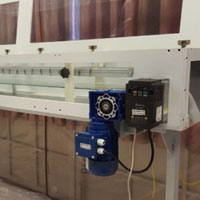A continuous high voltage electrostatic field system for thawing food materials

HTML: 107
All claims expressed in this article are solely those of the authors and do not necessarily represent those of their affiliated organizations, or those of the publisher, the editors and the reviewers. Any product that may be evaluated in this article or claim that may be made by its manufacturer is not guaranteed or endorsed by the publisher.
Authors
A laboratory continuous high voltage electrostatic field thawing system was designed and constructed in accordance with standards for food machinery. A corona discharge in wire-plate electrodes was considered for the system and a stainless-steel sheet was utilized as conveyor belt. A corona flow was created by using high voltage of 15, 20, and 25 kV and electrode gaps of 6, 8, and 10 cm. To evaluate the system, frozen tylose MH4000 gel with a moisture content of 77% w.b. as a meat analog was thawed from –10 to 0°C. The thawing duration, which was mostly aimed at increasing the temperature of a control sample (no electrostatic field), considerably decreased when the gel was thawed in the presence of high voltage. High voltage and electrode gap showed a significant effect on both thawing duration and specific energy consumption (P˂0.0001). The thawing duration decreased significantly by decreasing the electrode gap and increasing the applied voltage. In terms of energy consumption, the best condition (minimum specific energy consumption of 10.33 kJ kg–1) was obtained for 15 kV, and an electrode gap of 10 cm.
How to Cite

This work is licensed under a Creative Commons Attribution-NonCommercial 4.0 International License.
PAGEPress has chosen to apply the Creative Commons Attribution NonCommercial 4.0 International License (CC BY-NC 4.0) to all manuscripts to be published.

 https://doi.org/10.4081/jae.2021.1163
https://doi.org/10.4081/jae.2021.1163



